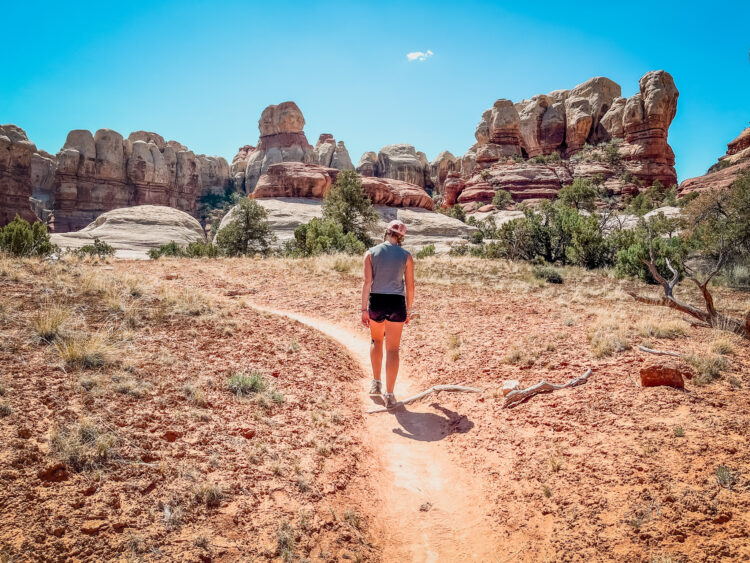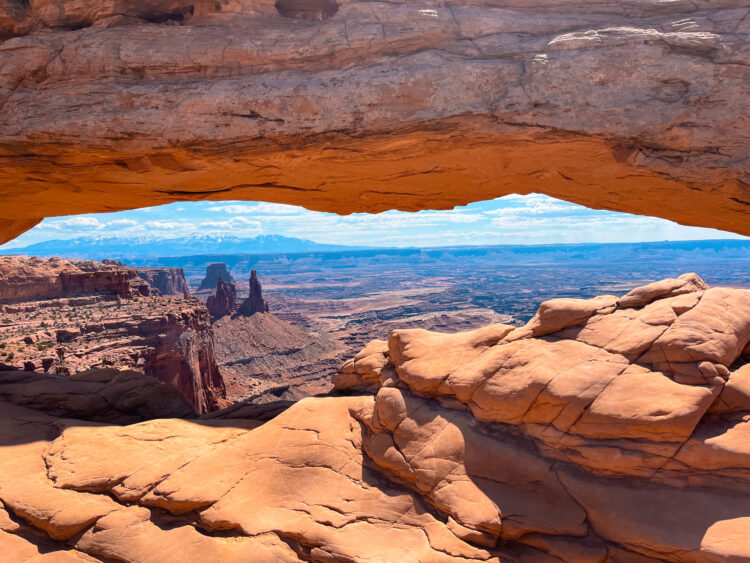With rocky mountain peaks covered in snow, frozen rivers, and stunning forests, the White Mountains are a gorgeous winter destination. Hiking in the white mountains in the winter is incredible and there is a variety of terrain you can explore whether you are new to winter hiking or have experience in the backcountry. Below you can see our list of the best winter hikes in the White Mountains.
Before we dive in, don’t be fooled by the low elevation of the White Mountains. The White Mountain have notoriously bad weather and it’s important to be prepared and take these mountains seriously. You can see more about winter safety in the White Mountains in the Things to Know Section below or see our Winter Hiking Guide to get started hiking during the cold season.
Quick Look at the 13 Best Winter Hikes in the White Mountains
Here is a quick list of some of the best hikes in the White Mountains for winter hiking. These trails range in length and difficulty. You can see details of each hike below.
- Boulder Loop Trail
- Arethusa Falls
- Mount Pemigewasset
- The Flume Gorge
- Welch Dickey Loop Trail
- Mount Moosilauke
- The Moats
- The Base of Tuckerman’s Ravine
- Mount Willard
- Webster-Jackson Trail, Mount Jackson
- Mount Field and Mount Tom
- Mount Roberts
- Mount Cardigan
- Lonesome Lake
- Mount Major
(Note that several of these are just south of the White Mountains in Mid-Southern NH)
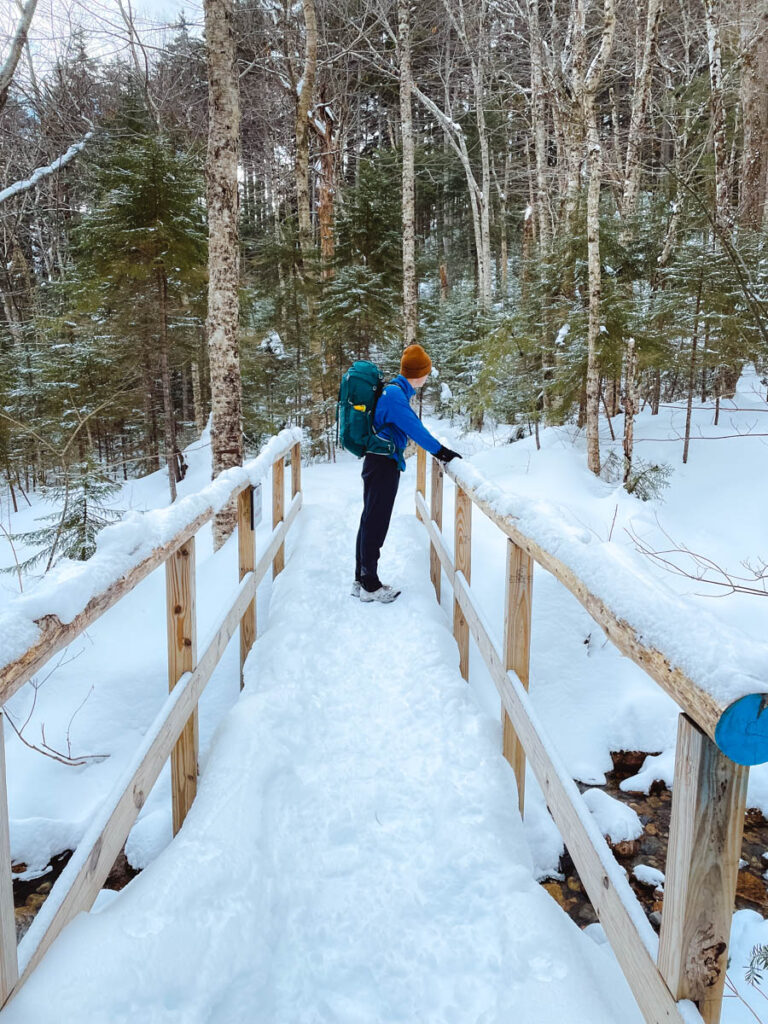
Map of the Winter Hikes in the White Mountains
Things to Know About Winter Hiking in the White Mountains
The most important thing to remember when venturing out in the winter in the White Mountains is to not underestimate these mountains. Despite their seemingly short height compared to other mountain ranges, the White Mountains see fatalities every year of people who head out to hike these mountains and don’t take the changing weather or the difficulty seriously.
With that out of the way, hiking the White Mountains in the winter can be incredible and with the proper gear, preparations and planning, is beautiful and rewarding and you can find plenty of hiking trail whether you are an experience winter hiker or will be winter hiking for the first time.
Check the Weather
Before heading out on any winter hike make sure to check the weather and remember that the high peaks will be much colder and windier than the valleys. You can see a good weather forecast for the different peaks at this link:
Driving and Parking in the White Mountains in the Winter
Most of the main roads throughout the White Mountains are well maintained throughout the winter – this includes many of the parking lots, although some mountain or dirt roads are not plowed. All the hikes listed here have some parking area either in a plowed lot of on the side of the road. Note that it may take several hours or even days after a major snowfall to get to some of the areas plowed and cleared out.
Winter Hiking Packing List
Packing correctly for winter hiking is incredibly important. Make sure to dress in layers and bring more clothing than you plan to wear. Always assume that something could hold you up and you want to be prepared to spend more time on the hike than you plan. You should also wear appropriate footwear including microspikes, snowshoes, or even crampons. Also pack plenty of food and water and keep your water in your pack to keep it from freezing. Finally make sure you pack a light, first aid kit, and navigation equipment.
You can see a winter hiking packing list here.
13 Best Winter Hikes in the White Mountains
Boulder Loop Trail
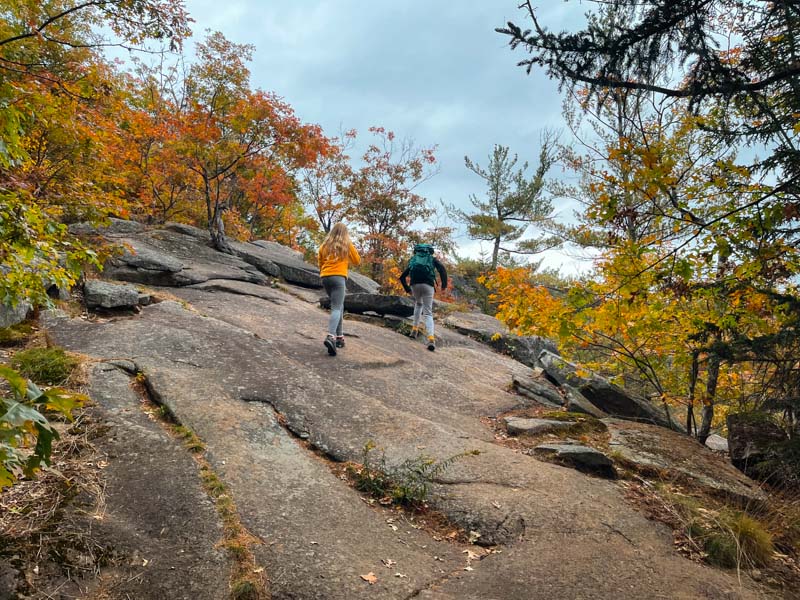
Distance: 3.5 miles Elevation Gain: 930 feet Difficulty: Moderate/easy
The Boulder Loop Trail is a great winter hike and is also one of our favorite fall foliage hikes in the White Mountains. Beginning at the Albany covered bridge, the loop trail takes you uphill to a series of cliffs with views out across the Kancamagus highway. The trail walks along the edge of the cliffs with a small spur to the best views before descending and returning to the trailhead through a forested path path some large Boulders.
This is a fun winter hiking trail and good beginner hike with some views. See more about hiking the Boulder Loop Trail.
Arethusa Falls
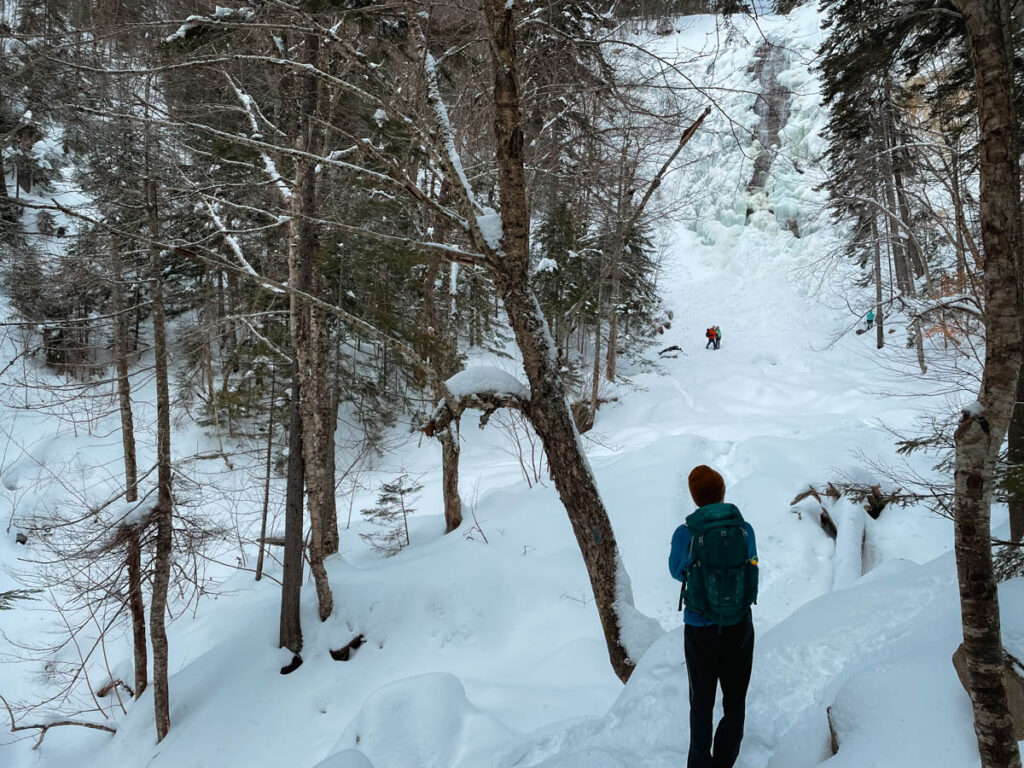
Distance: 2.8 miles Elevation Gain:775 feet Difficulty: Easy to Moderate
This is a great hike at any time of year, but is a beautiful hike in the winter. You have 2 options for this hike. You can hike up directly on the Arethusa Falls Trail or take the Bemis Brook Trail up to join with the main trail. The Bemis Brook Trail is my favorite, specifically when the stream isn’t frozen.
This winter hike is best done in early or late winter if you want to see some of the waterfall flowing otherwise you are likely to just see the ice and potentially ice climbers. The trail itself gradually gains elevation over the entire trail with no steep sections.
Mount Pemigewasset

Distance: 3.7 miles Elevation Gain: 1,250 feet Difficulty: Moderate
Mount Pemigewasset offers a short winter hike with great views on the western side of the White Mountains. The trailhead is right off Highway 93 making it easy to get to and you can park in the same lot as the popular Flume Gorge. The Trail crosses under the highway and then begins ascending steadily and moderately steeply for the first mile and a half.
At this point the trail goes left across a ridge line until it reaches the viewpoint near the summit. The views from here look west and you can see out across the Franconia Notch area.
The Flume Gorge Trail
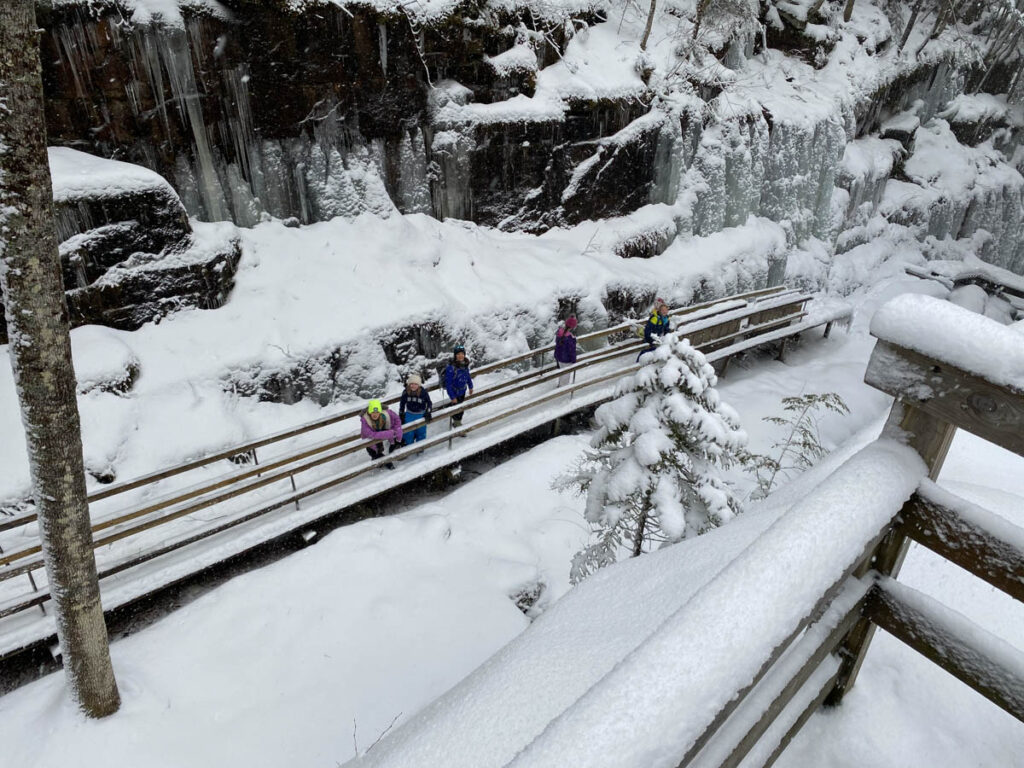
Distance: 2 Miles Elevation Gain: 500 feet Difficulty: Easy
This is a lovely trail and the best time to hike the Flume Gorge is during the winter. While the boardwalks through the gorge are closed in the winter – there is still plenty of gorgeous views of the frozen waterfalls and flowing water.
While we love this hike – the crowds and high fee to visit during the summer isn’t worth it.
The Flume Gorge passes through a covered bridge before following the gorge uphill and looping back to the parking lot through a wide and easy trail. This is one of the best easy winter hikes in NH.
Welch Dickey Loop Trail

Distance: 4.4 miles Elevation Gain: 1,778 feet Difficulty: Challenging
This trail is a classic NH hike with incredible views for most of the hike. The trail does pass near the cliff edge so if you are hiking here in the winter, use extra caution. The trail is steep in several sections as it ascends and then follow a ridgeline between Welch and Dickey.
For the length of the trail, this has some of the best views in the White Mountains.
The trail does cross a stream that can be tricky if the stream is only partially frozen during the winter.
See more about Hiking the Welch Dickey Loop.
Mount Moosilauke

Distance: 8 miles (depending on where you park) Elevation Gain: 2,700 feet Difficulty: Challenging
Mount Moosilauke is a great hike and is one of the tallest peaks in the White Mountains. There are many ways to do this hike but one of the best ways is by taking the Gorge Brook Trail and South Peak Loop. Moosilauke is a steady hike and while it’s considered challenging, there are no crazy steep sections.
Note that the summit and top part of the hike is very exposed and since this is a tall peak, it’s more important to keep an eye of the weather, specifically if it will be windy.
See more about hiking Mount Moosilauke.
The Moats

Distance: 6 miles Elevation Gain: 2,280 feet Difficulty: Challenging
If you’ve spent time winter hiking in New Hampshire and are ready to make the step from easy winter hikes to something a bit more challenging, the Moats are a great choice. We’ve winter hiked South Moat with our kids and while it is fairly steep in the way up, this section of the trail is protected by trees.
Once you get near the summit of South Moat, the views begin to open up and you follow a ridge to the summit. From here you can see the summit of Middle Moat. It is a beautiful, if exposed, hike between the two summits. Since this is an out and back trail, you can also turn around when you’ve enjoyed enough of the hike.
The Base of Tuckerman’s Ravine

Distance: 5.3 miles Elevation Gain: 1,800 feet Difficulty: Moderate
This is a different and fun hike up to the base of Tuckerman’s Ravine. Unlike the other hikes on this list that involve hiking to a summit or waterfall, this hike ends at AMC building called HoJos. This is a popular place for people to climb up Tuckerman’s Ravine and ski down one of the shoots.
This is a popular hiking and ski trail and it is fun to hike up and watch the skiers or simply take in the views of Mount Washington looming overhead. If you want to ski, the trail down from Tuckerman’s is a moderate ski or you can simply hike up and down on the Tuckerman Ravine Trail.
Mount Willard
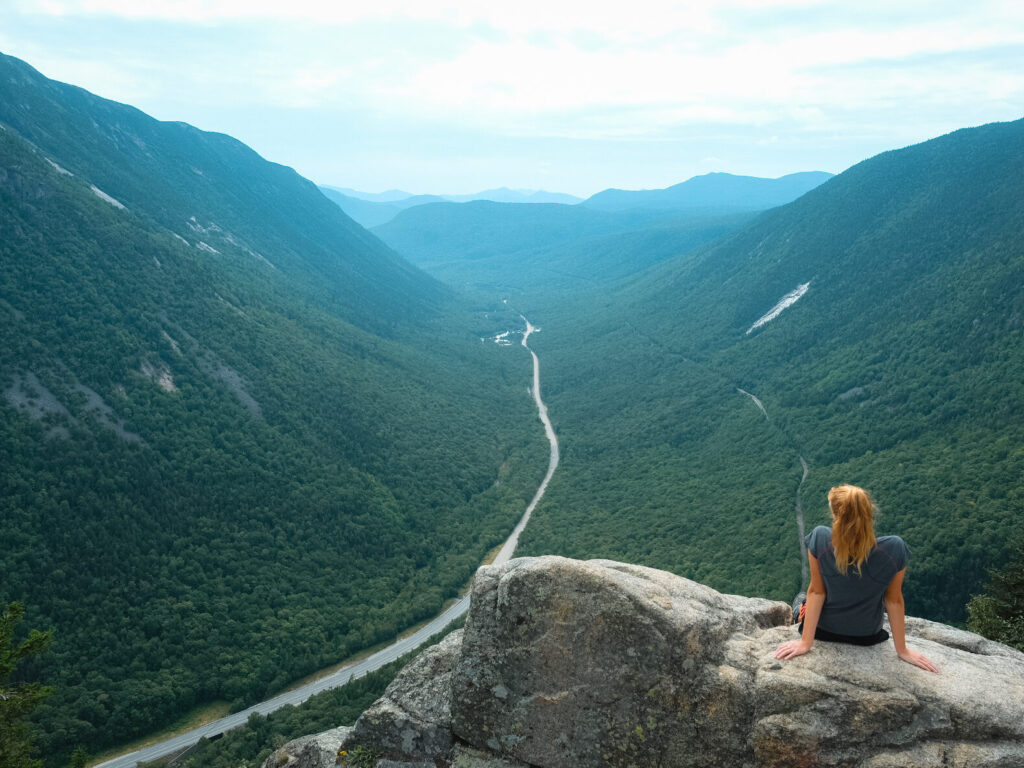
Distance: 3 miles Elevation Gain: 900 feet Difficulty: moderate
This iconic hike is a great white mountains New Hampshire winter trail. You’ve likely seen photos of the view from the top of Mount Willard during the fall foliage season, but winter is also a great time to visit.
The trail is wide and gains elevation steadily until reaching the summit and the cliffs the face south through Crawford Notch. Use caution from the viewpoint as there is a steep and long drop. This is one of the easier winter hikes in the White Mountains with a view.
See more about hiking Mount Willard.
Webster-Jackson Trail to Mount Jackson
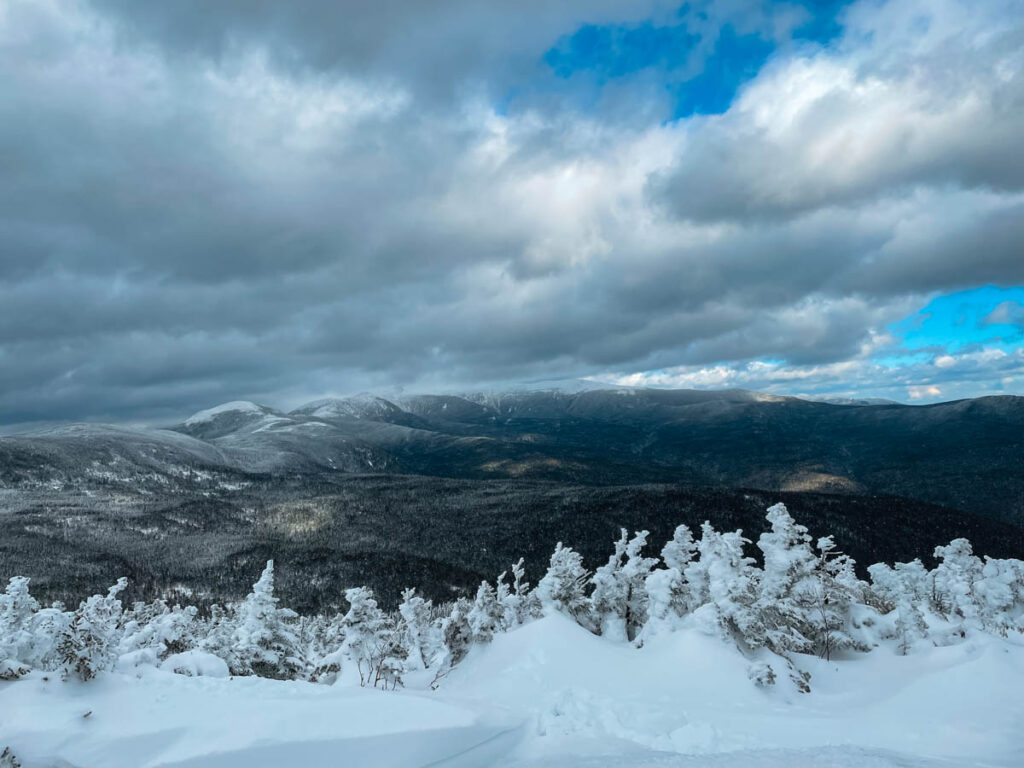
Distance: 6.4 miles Elevation Gain: 2,400 feet Difficulty: challenging
The Jackson-Webster Trail is gem and a wonderful winter hiking trail that leads to the summit of Mount Jackson – one of the shorter 4,000 footers in the White Mountains. This is a moderate winter hike with 360 degree views from the summit. The views look across Crawford Notch as well as the Presidential Range.
The Jackson-Webster Trail has several other viewpoints on the way up including Elephant Head and Bugle Cliff.
Mount Field and Mount Tom

Distance: 6.5 miles Elevation Gain: 2,700 feet Difficulty: moderate
Starting from the same trailhead as Mount Willard, this loop trail with a short spur ascends two 4,000 footers. Hike the trail in a clockwise direction by ascending to Mount Avalon first. This gives you the best views of the hike and gets the steep section out of the way on the way up. From Mount Avalon continue up to Mount Field.
Besides the steep section up to Mount Avalon the trail is generally gradual. Mount Field is partially tree covered with several viewing areas. Take a short spur to reach the summit of Mount Tom.
See more about hiking Mount Field, Tom and Avalon
Mount Roberts

Distance: 5.2 miles Elevation Gain: 1,330 feet Difficulty: moderate
Mount Roberts is technically a bit south of the White Mountains National Forest in the Ossipee Mountain. The trail is within the region known as in Castle of the Clouds and has views out over Lake Winnipesauke. This is a good winter hike for beginners as the trail has great views but is not too steep at any point. It’s also an out and back trail so you can turn around whenever you want and still get some incredible views.
Mount Cardigan

Distance: 3 miles Elevation Gain: 1,100 feet Difficulty: Moderate
This is a great hike with views of Mount Monadnock. You can hike this as an out and back or do it as a loop with a few different options for hiking trails. The top section of this hike is all out of the trees and exposed so it is cold if there is a lot of wind, but also offers great views. We chose to hike up the West Ridge Trail and down the South Ridge Trail.
This is a good winter hiking trail to try if you’ve done a few of the shorter hikes and want to try something a little longer.
Lonesome Lake
Distance: 3.1 miles Elevation Gain: 1,000 feet Difficulty: Moderate
While I listed this as moderate it is generally an easy trail without any steep sections. The trail is entirely in the woods and leads up to the pretty Lonesome Lake surrounded by mountains and the backside of Cannon Mountain.
The trail is rocky in the summer, but is usually well packed in the winter and is a popular hike and one of the best easy winter hiking trails in the White Mountain. There is also a Lonesome Lake hut at the top. The hut is self catering during the winter, but still offers a place to pause and warm up during the winter.
Mount Major
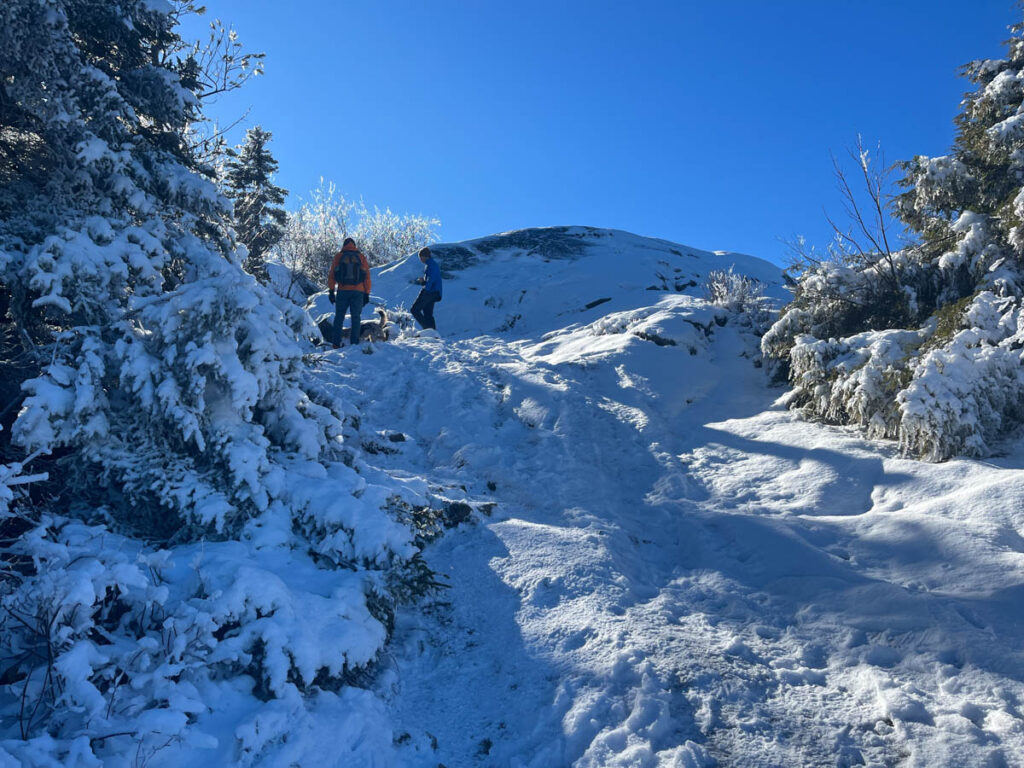
Distance: 3.8 miles Elevation 1,150 feet Difficulty: Moderate
This is another hike that is technically south of the While Mountains in the Belnap Range near Lake Winnipesauke. One of the most popular hikes in New Hampshire, winter is a great time to do this hike when the crowds stay home. We hiked this most recently on a Saturday in January and had plenty of place in the parking lot.
You can hike Mount Major in a number of directions, but we recommend the Boulder Loop Trail to Brook Trail.
See more about hiking Mount Major.
The White Mountains are an amazing place to hike in the winter – let us know your favorite White Mountain winter hike in the comments below.




